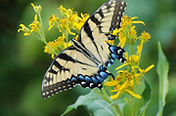redbreasted merganser (Mergus serrator)
CONFIRMATION STATUS: Confirmed.
IDENTIFICATION:
-
Length: 16 inches Wingspan: 33 inches
-
Large, sleek diving duck
-
Long, pointed bill with serrated edges
-
Thin, red bill seems evenly tapered throughout length
-
Shaggy crest obvious in both sexes
-
Red eye
-
White secondaries
-
Immature similar to adult female
Adult male:
-
Greenish-black head
-
White neck
-
Reddish breast with dark streaks, bordered on sides by black-and- white patch
-
Gray flanks, tail, rump and uppertail coverts
-
Black back
-
White belly
-
White secondary coverts
-
Alternate plumage worn from fall through early summer
-
Male in basic eclipse plumage like adult female
Adult female:
-
Red-brown head, paler on throat, but without well-defined chin
-
Red-brown head fades evenly to paler breast
-
Gray and white breast and belly
-
Gray-brown body plumage
Similar species:
Adult male in alternate plumage is similar to male common merganser
but has reddish breast and gray flanks. Female, immature and eclipse
male distinguished from similarly-plumaged common mergansers by
lack of sharply-defined chin and lack of sharp contrast between reddish
head and white breast, and by darker gray plumage, spikier crest, and
slimmer bill. In winter, Red-breasted mergansers are more likely to be
found in saltwater habitats than are common mergansers.
LIFE HISTORY
Migration Status: N/A
Breeding Habitat: N/A
Nest Location: N/A
Nest Type: N/A
Clutch Size: 7-12
Length of Incubation: 30(29-35) days
Days to Fledge: 59(<65)
Number of Broods: 1
Diet: Mostly fish; lesser quantities of aquatic invertebrates
SKY MEADOWS DISTRIBUTION/SEASONAL OCCURRENCE
Relative abundance and seasonal occurrence are indicated in red below.
Relative abundance
C - Common: Likely to be present in good numbers in appropriate habitat and season.
U - Uncommon: May be present in appropriate habitat and season, often in low
numbers.
O - Occassional: Found in appropriate habitat perhaps only a few times per season,
sometimes low numbers.
R - Rare: May not be recorded every year.
Acc - Accidental: Recorded once or twice, may not be expected again for a long time.
Seasonal Occurrence
Sp - Spring: March, April, May R
Su - Summer: June, July, August
Fall: September, October, November
Winter: December, January, February
Park Activities
Calendar of Events
Volunteer Programs
Sky Meadows Park
Location
Geography
Habitats
Trails
Visiting Park
Crooked Run Valley
Special Projects


